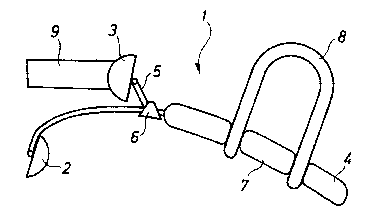Une partie des informations de ce site Web a été fournie par des sources externes. Le gouvernement du Canada n'assume aucune responsabilité concernant la précision, l'actualité ou la fiabilité des informations fournies par les sources externes. Les utilisateurs qui désirent employer cette information devraient consulter directement la source des informations. Le contenu fourni par les sources externes n'est pas assujetti aux exigences sur les langues officielles, la protection des renseignements personnels et l'accessibilité.
L'apparition de différences dans le texte et l'image des Revendications et de l'Abrégé dépend du moment auquel le document est publié. Les textes des Revendications et de l'Abrégé sont affichés :
| (12) Demande de brevet: | (11) CA 2344062 |
|---|---|
| (54) Titre français: | ATTELLE POUR HALLUX VALGUS |
| (54) Titre anglais: | HALLUX VALGUS BRACE |
| Statut: | Réputée abandonnée et au-delà du délai pour le rétablissement - en attente de la réponse à l’avis de communication rejetée |
| (51) Classification internationale des brevets (CIB): |
|
|---|---|
| (72) Inventeurs : |
|
| (73) Titulaires : |
|
| (71) Demandeurs : |
|
| (74) Agent: | SMART & BIGGAR LP |
| (74) Co-agent: | |
| (45) Délivré: | |
| (86) Date de dépôt PCT: | 1999-09-15 |
| (87) Mise à la disponibilité du public: | 2000-03-23 |
| Licence disponible: | S.O. |
| Cédé au domaine public: | S.O. |
| (25) Langue des documents déposés: | Anglais |
| Traité de coopération en matière de brevets (PCT): | Oui |
|---|---|
| (86) Numéro de la demande PCT: | PCT/SE1999/001608 |
| (87) Numéro de publication internationale PCT: | WO 2000015163 |
| (85) Entrée nationale: | 2001-03-14 |
| (30) Données de priorité de la demande: | ||||||
|---|---|---|---|---|---|---|
|
L'invention se rapporte à une attelle pour hallux valgus, c'est-à-dire une attelle conçue pour le traitement d'hallux valgus non rigide. Cette attelle comporte un organe à effet de levier en trois points qui permet de corriger la position du gros orteil. Conformément à cette invention, la totalité de l'attelle (1) est conçue pour être placée à distance de l'articulation métatarsienne. De préférence, cette attelle comporte un coussinet proximal (2) qui fait pression sur la première phalange du gros orteil, un coussinet distal (3) qui fait pression sur la partie distale de la première phalange du gros orteil et un bras de levier (4) qui fait pression sur l'extrémité antérieure de la plante du pied. Cette attelle peut être portée pour la marche et d'autres activités.
The invention relates to a hallux valgus brace, i.e. a brace designed for
treatment of non-rigid hallux valgus. The brace comprises a three point lever
means for correcting the position of the big toe. According to the invention
the complete brace (1) is designed to be located distally of the metatarsal
joint. Preferably, the brace comprises a proximal pad (2) pressing on the
first phalanx of the big toe, a distal pad (3) pressing on the distal end of
the first phalanx of the big toe, and a lever arm (4) pressing on the ball of
the foot. The brace can be used during walking and other activities.
Note : Les revendications sont présentées dans la langue officielle dans laquelle elles ont été soumises.
Note : Les descriptions sont présentées dans la langue officielle dans laquelle elles ont été soumises.

2024-08-01 : Dans le cadre de la transition vers les Brevets de nouvelle génération (BNG), la base de données sur les brevets canadiens (BDBC) contient désormais un Historique d'événement plus détaillé, qui reproduit le Journal des événements de notre nouvelle solution interne.
Veuillez noter que les événements débutant par « Inactive : » se réfèrent à des événements qui ne sont plus utilisés dans notre nouvelle solution interne.
Pour une meilleure compréhension de l'état de la demande ou brevet qui figure sur cette page, la rubrique Mise en garde , et les descriptions de Brevet , Historique d'événement , Taxes périodiques et Historique des paiements devraient être consultées.
| Description | Date |
|---|---|
| Demande non rétablie avant l'échéance | 2005-09-15 |
| Le délai pour l'annulation est expiré | 2005-09-15 |
| Inactive : IPRP reçu | 2004-11-04 |
| Inactive : Abandon.-RE+surtaxe impayées-Corr envoyée | 2004-09-15 |
| Réputée abandonnée - omission de répondre à un avis sur les taxes pour le maintien en état | 2004-09-15 |
| Lettre envoyée | 2001-10-24 |
| Inactive : Transfert individuel | 2001-09-19 |
| Inactive : Page couverture publiée | 2001-06-11 |
| Inactive : CIB en 1re position | 2001-06-03 |
| Inactive : Lettre de courtoisie - Preuve | 2001-05-29 |
| Inactive : Notice - Entrée phase nat. - Pas de RE | 2001-05-24 |
| Demande reçue - PCT | 2001-05-15 |
| Demande publiée (accessible au public) | 2000-03-23 |
| Date d'abandonnement | Raison | Date de rétablissement |
|---|---|---|
| 2004-09-15 |
Le dernier paiement a été reçu le 2003-08-19
Avis : Si le paiement en totalité n'a pas été reçu au plus tard à la date indiquée, une taxe supplémentaire peut être imposée, soit une des taxes suivantes :
Veuillez vous référer à la page web des taxes sur les brevets de l'OPIC pour voir tous les montants actuels des taxes.
| Type de taxes | Anniversaire | Échéance | Date payée |
|---|---|---|---|
| Taxe nationale de base - générale | 2001-03-14 | ||
| TM (demande, 2e anniv.) - générale | 02 | 2001-09-17 | 2001-09-07 |
| Enregistrement d'un document | 2001-09-19 | ||
| TM (demande, 3e anniv.) - générale | 03 | 2002-09-16 | 2002-08-23 |
| TM (demande, 4e anniv.) - générale | 04 | 2003-09-15 | 2003-08-19 |
Les titulaires actuels et antérieures au dossier sont affichés en ordre alphabétique.
| Titulaires actuels au dossier |
|---|
| CAMP SCANDINAVIA AB |
| Titulaires antérieures au dossier |
|---|
| JAN SMITS |